be动词,一般动词和助动词
- 格式:doc
- 大小:44.60 KB
- 文档页数:14
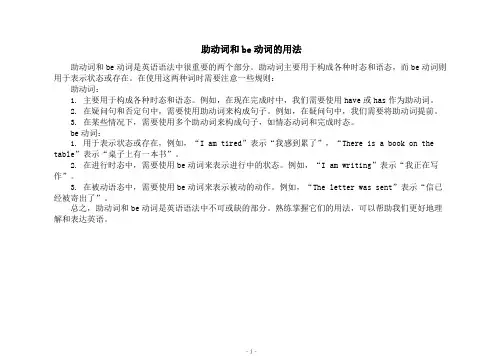
助动词和be动词的用法
助动词和be动词是英语语法中很重要的两个部分。
助动词主要用于构成各种时态和语态,而be动词则用于表示状态或存在。
在使用这两种词时需要注意一些规则:
助动词:
1. 主要用于构成各种时态和语态。
例如,在现在完成时中,我们需要使用have或has作为助动词。
2. 在疑问句和否定句中,需要使用助动词来构成句子。
例如,在疑问句中,我们需要将助动词提前。
3. 在某些情况下,需要使用多个助动词来构成句子,如情态动词和完成时态。
be动词:
1. 用于表示状态或存在,例如,“I am tired”表示“我感到累了”,“There is a book on the table”表示“桌子上有一本书”。
2. 在进行时态中,需要使用be动词来表示进行中的状态。
例如,“I am writing”表示“我正在写作”。
3. 在被动语态中,需要使用be动词来表示被动的动作。
例如,“The letter was sent”表示“信已经被寄出了”。
总之,助动词和be动词是英语语法中不可或缺的部分。
熟练掌握它们的用法,可以帮助我们更好地理解和表达英语。
- 1 -。
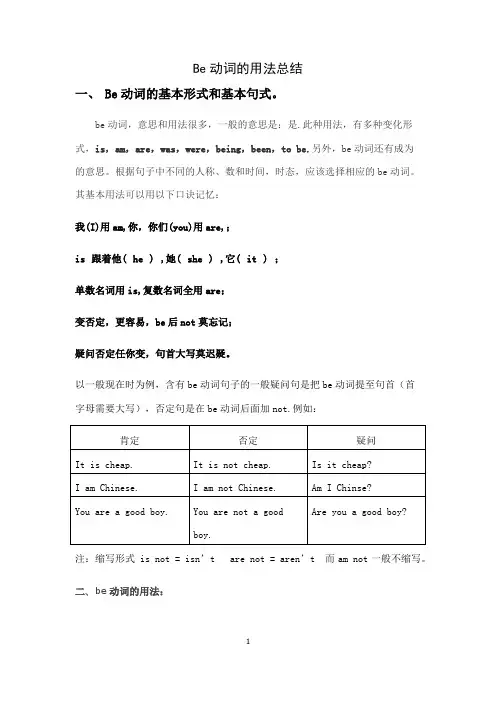
Be动词的用法总结一、 Be动词的基本形式和基本句式。
be动词,意思和用法很多,一般的意思是:是.此种用法,有多种变化形式,is,am,are,was,were,being,been,to be.另外,be动词还有成为的意思。
根据句子中不同的人称、数和时间,时态,应该选择相应的be动词。
其基本用法可以用以下口诀记忆:我(I)用am,你,你们(you)用are,;is跟着他(he),她(she),它(it);单数名词用is,复数名词全用are;变否定,更容易,be后not莫忘记;疑问否定任你变,句首大写莫迟疑。
以一般现在时为例,含有be动词句子的一般疑问句是把be动词提至句首(首字母需要大写),否定句是在be动词后面加not.例如:注:缩写形式 is not = isn’t are not = aren’t 而am not一般不缩写。
二、be动词的用法:(一)系动词be作为系动词(也叫连系动词,link verb)的be,是英语学习者接触最早的用法,而且其用法也很多。
其基本含义为“是”,基本用法结构为“主语+be+表语”,也就是我们常说的主系表结构,其中的表语一般都由名词、形容词、数词或表地点、时间等的短语来充当。
系动词be有各种时态的变化,也会和情态动词连用。
1、be的时态变化系动词be会有一般现在时、一般过去时、一般将来时、现在完成时、过去完成时等的时态变化。
如:He is a student.They were in the park yesterday.It will be cloudy tomorrow.He has been ill for six days.It had been three hours before she left the hat shop.2、be与情态动词的连用其用法为:情态动词+系动词be原形。
如:It must be Lucy's book. Her name is on the cover.It can be very difficult for us to memorize too many words within such a short time.She should be here on time tomorrow.(二)助动词be作为助动词,be没有具体含义,而是与主要动词一起构成句子的谓语动词。
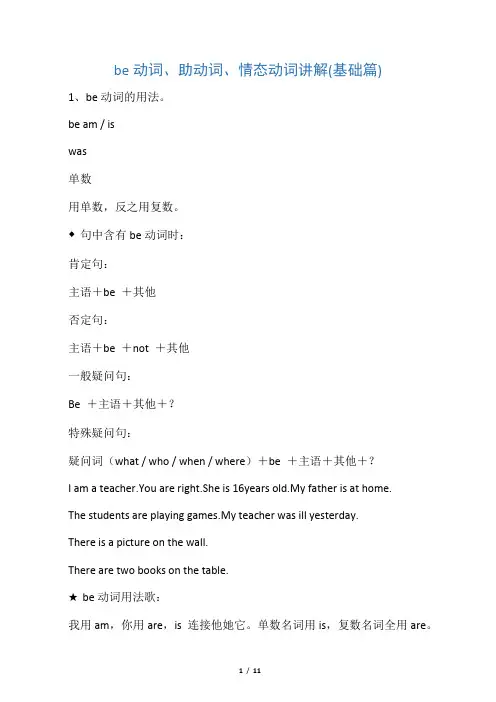
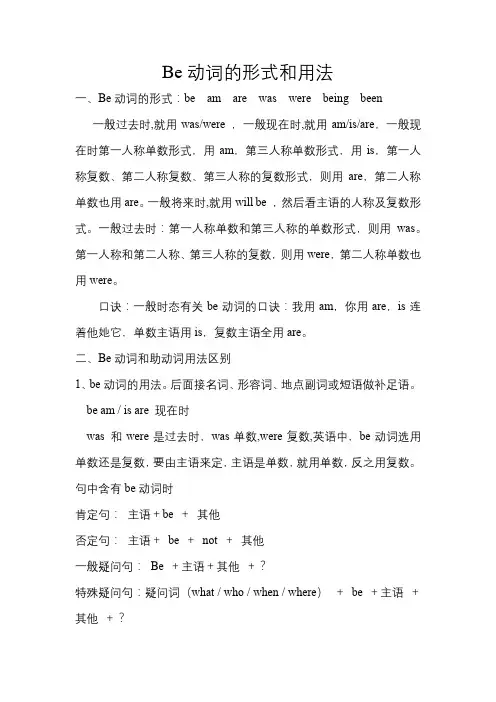
Be动词的形式和用法一、Be动词的形式:be am are was were being been一般过去时,就用was/were ,一般现在时,就用am/is/are,一般现在时第一人称单数形式,用am,第三人称单数形式,用is,第一人称复数、第二人称复数、第三人称的复数形式,则用are,第二人称单数也用are。
一般将来时,就用will be ,然后看主语的人称及复数形式。
一般过去时:第一人称单数和第三人称的单数形式,则用was。
第一人称和第二人称、第三人称的复数,则用were,第二人称单数也用were。
口诀:一般时态有关be动词的口诀:我用am,你用are,is连着他她它,单数主语用is,复数主语全用are。
二、Be动词和助动词用法区别1、be动词的用法。
后面接名词、形容词、地点副词或短语做补足语。
be am / is are 现在时was 和were是过去时,was单数,were复数,英语中,be动词选用单数还是复数,要由主语来定,主语是单数,就用单数,反之用复数。
句中含有be动词时肯定句:主语+be +其他否定句:主语+be +not +其他一般疑问句:Be +主语+其他+?特殊疑问句:疑问词(what / who / when / where)+be +主语+其他+?如:I am a teacher.You are right.She is 16 years old.My father is at home.The students are playing games.My teacher was ill yesterday.There is a picture on the wall.There are two books on the table.be动词用法歌:我用am,你用are,is 连接他她它。
单数名词用is,复数名词全用are。
变疑问,往前提,句末问号莫丢弃;变否定,更容易,be后not莫忘记;疑问否定任你变,句首大写莫迟疑。
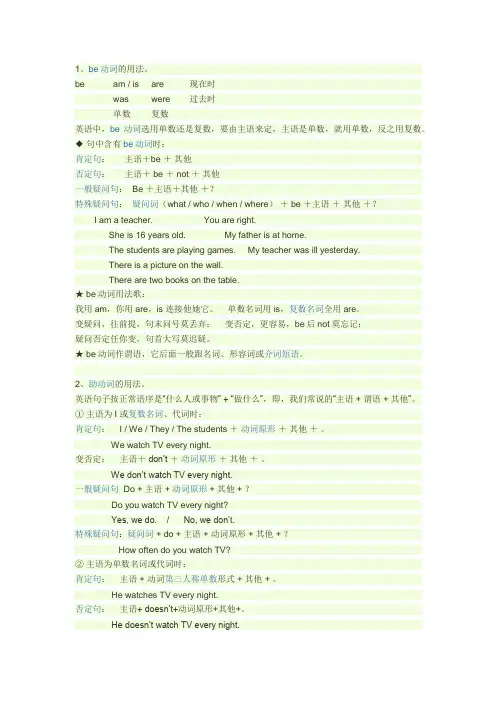
1、be动词的用法。
be am / is are 现在时was were 过去时单数复数英语中,be动词选用单数还是复数,要由主语来定,主语是单数,就用单数,反之用复数。
◆句中含有be动词时:肯定句:主语+be +其他否定句:主语+ be + not +其他一般疑问句: Be +主语+其他+?特殊疑问句:疑问词(what / who / when / where)+ be +主语+其他+?I am a teacher. You are right.She is 16 years old. My father is at home.The students are playing games. My teacher was ill yesterday.There is a picture on the wall.There are two books on the table.★ be动词用法歌:我用am,你用are,is 连接他她它。
单数名词用is,复数名词全用are。
变疑问,往前提,句末问号莫丢弃;变否定,更容易,be后not莫忘记;疑问否定任你变,句首大写莫迟疑。
★ be动词作谓语,它后面一般跟名词、形容词或介词短语。
2、助动词的用法。
英语句子按正常语序是“什么人或事物” + “做什么”,即,我们常说的“主语 + 谓语 + 其他”。
①主语为I 或复数名词、代词时:肯定句: I / We / They / The students +动词原形+其他+。
We watch TV every night.变否定:主语+don’t +动词原形+其他+。
We don’t watch TV every night.一般疑问句 Do + 主语 + 动词原形 + 其他 + ?Do you watch TV every night?Yes, we do. / No, we don’t.特殊疑问句:疑问词 + do + 主语 + 动词原形 + 其他 + ?How often do you watch TV?②主语为单数名词或代词时:肯定句:主语 + 动词第三人称单数形式 + 其他 + 。
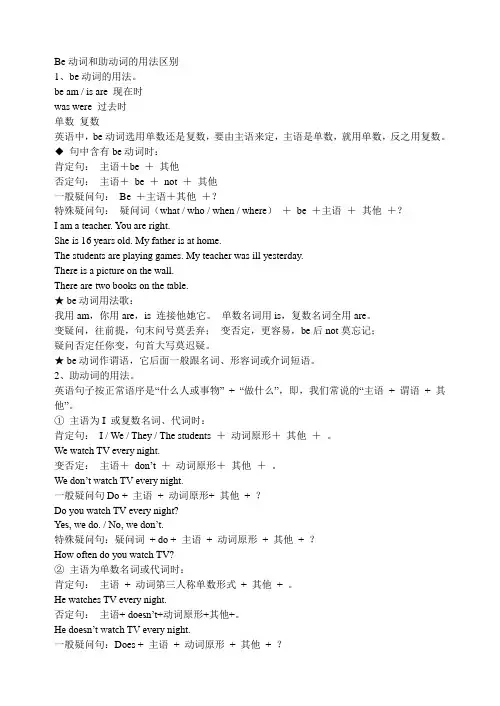
Be动词和助动词的用法区别1、be动词的用法。
be am / is are 现在时was were 过去时单数复数英语中,be动词选用单数还是复数,要由主语来定,主语是单数,就用单数,反之用复数。
◆句中含有be动词时:肯定句:主语+be +其他否定句:主语+be +not +其他一般疑问句:Be +主语+其他+?特殊疑问句:疑问词(what / who / when / where)+be +主语+其他+?I am a teacher. You are right.She is 16 years old. My father is at home.The students are playing games. My teacher was ill yesterday.There is a picture on the wall.There are two books on the table.★ be动词用法歌:我用am,你用are,is 连接他她它。
单数名词用is,复数名词全用are。
变疑问,往前提,句末问号莫丢弃;变否定,更容易,be后not莫忘记;疑问否定任你变,句首大写莫迟疑。
★ be动词作谓语,它后面一般跟名词、形容词或介词短语。
2、助动词的用法。
英语句子按正常语序是“什么人或事物” + “做什么”,即,我们常说的“主语+ 谓语+ 其他”。
①主语为I 或复数名词、代词时:肯定句:I / We / They / The students +动词原形+其他+。
We watch TV every night.变否定:主语+don’t +动词原形+其他+。
We don’t watch TV every night.一般疑问句Do + 主语+ 动词原形+ 其他+ ?Do you watch TV every night?Yes, we do. / No, we don’t.特殊疑问句:疑问词+ do + 主语+ 动词原形+ 其他+ ?How often do you watch TV?②主语为单数名词或代词时:肯定句:主语+ 动词第三人称单数形式+ 其他+ 。
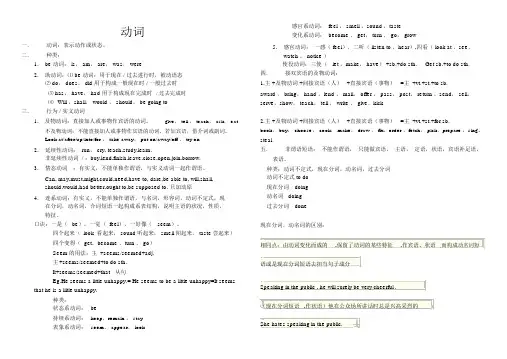
动词一.动词:表示动作或状态。
二.种类:1.be 动词: is, am, are, was, were2.助动词:⑴ be 动词:用于现在 / 过去进行时,被动语态⑵ do, does, did 用于构成一般现在时 / 一般过去时⑶ has, have, had 用于构成现在完成时/ 过去完成时⑷Will ,shall, would , should, be going to三.行为 / 实义动词1. 及物动词:直接加人或事物作宾语的动词。
give, tell , teach, ask, eat不及物动词:不能直接加人或事物作宾语的动词,若加宾语,借介词或副词。
Look at/after/up/into/for , take away, put on/away/off , try on.2.延续性动词: run, cry, teach,study,learn.非延续性动词 / :buy,lend,finish,leave,close,open,join,borrow.3.情态动词:有实义,不能单独作谓语,与实义动词一起作谓语。
Can, may,must,might,could,need,have to, dare,be able to, will,shall,should,would,had better,ought to,be supposed to. 只加动原4.连系动词:有实义,不能单独作谓语,与名词,形容词,动词不定式,现在分词,动名词,介词短语一起构成系表结构,说明主语的状况,性质,特征。
口诀:一是(be),一觉( feel),一好像(seem)。
四个起来( look 看起来, sound 听起来, smell 闻起来, taste 尝起来)四个变得( get,become ,turn , go)Seem 的用法:主 +seems/seemed+adj.主+seems/seemed+to do sth.It+seems/seemed+that从句Eg.He seems a little unhappy.= He seems to be a little unhappy=It seems that he is a liitle unhappy.种类:状态系动词:be持续系动词:keep,remain , stay表象系动词:seem, appear, look感官系动词: feel , smell ,sound ,taste变化系动词: become , get, turn , go, grow5.感官动词:一感( feel),二听( listen to ,hear),四看( look at ,see,watch , notice )使役动词:三使(let ,make, have) +sb.+do sth.Get sb.+to do sth.四.接双宾语的及物动词:1.主 +及物动词 +间接宾语(人)+直接宾语(事物)=主 +vt.+st.+to sb.award , bring, hand ,lend , mail, offer , pass, post, return ,send, sell,serve,show, teach, tell , write , give,kick2.主 +及物动词 +间接宾语(人)+直接宾语(事物)=主 +vt.+st.+for sb.book, buy, choose, cook, make, draw , fix,order ,fetch, pick,prepare ,sing,steal五.非谓语短语:不能作谓语,只能做宾语,主语,定语,状语,宾语补足语,表语。
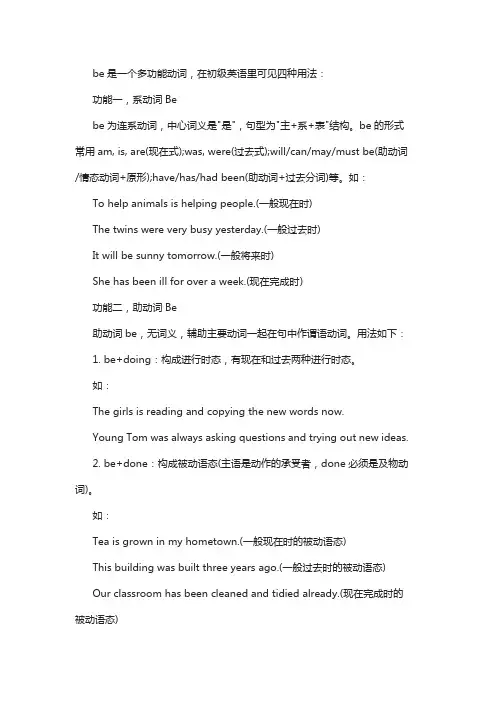
be是一个多功能动词,在初级英语里可见四种用法:功能一,系动词Bebe为连系动词,中心词义是"是",句型为"主+系+表"结构。
be的形式常用am, is, are(现在式);was, were(过去式);will/can/may/must be(助动词/情态动词+原形);have/has/had been(助动词+过去分词)等。
如:To help animals is helping people.(一般现在时)The twins were very busy yesterday.(一般过去时)It will be sunny tomorrow.(一般将来时)She has been ill for over a week.(现在完成时)功能二,助动词Be助动词be,无词义,辅助主要动词一起在句中作谓语动词。
用法如下:1. be+doing:构成进行时态,有现在和过去两种进行时态。
如:The girls is reading and copying the new words now.Young Tom was always asking questions and trying out new ideas.2. be+done:构成被动语态(主语是动作的承受者,done必须是及物动词)。
如:Tea is grown in my hometown.(一般现在时的被动语态)This building was built three years ago.(一般过去时的被动语态)Our classroom has been cleaned and tidied already.(现在完成时的被动语态)。
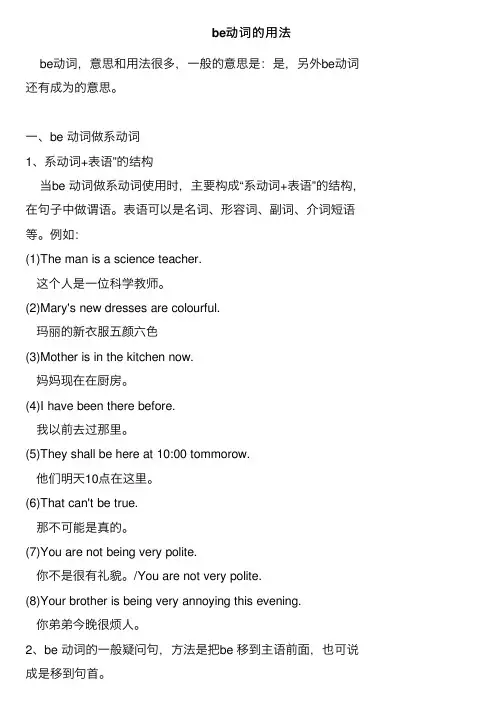
be动词的⽤法be动词,意思和⽤法很多,⼀般的意思是:是,另外be动词还有成为的意思。
⼀、be 动词做系动词1、系动词+表语”的结构当be 动词做系动词使⽤时,主要构成“系动词+表语”的结构,在句⼦中做谓语。
表语可以是名词、形容词、副词、介词短语等。
例如:(1)The man is a science teacher.这个⼈是⼀位科学教师。
(2)Mary's new dresses are colourful.玛丽的新⾐服五颜六⾊(3)Mother is in the kitchen now.妈妈现在在厨房。
(4)I have been there before.我以前去过那⾥。
(5)They shall be here at 10:00 tommorow.他们明天10点在这⾥。
(6)That can't be true.那不可能是真的。
(7)You are not being very polite.你不是很有礼貌。
/You are not very polite.(8)Your brother is being very annoying this evening.你弟弟今晚很烦⼈。
2、be 动词的⼀般疑问句,⽅法是把be 移到主语前⾯,也可说成是移到句⾸。
(1)Is the man a science teacher?Yes, he is. / No, he isn't.(2)Are Mary's new dresses colourful?Yes, they are. / No, they aren't.(3)Was mother in the kitchen then?Yes, she was. / No, she wasn't.(4)Were you at home the day before yesterday?Yes, I was. / No, I wasn't.(5)Was she late this morning?Yes, she was. / No, she wasn't.3、be 动词⽤在特殊疑问句在特殊疑问句⾥,be 动词仍然移到主语前⾯,但特殊疑问句是以特殊疑问词开头的,所以be 动词只能说是移到主语前⾯,或者说是在特殊疑问词的后⾯。
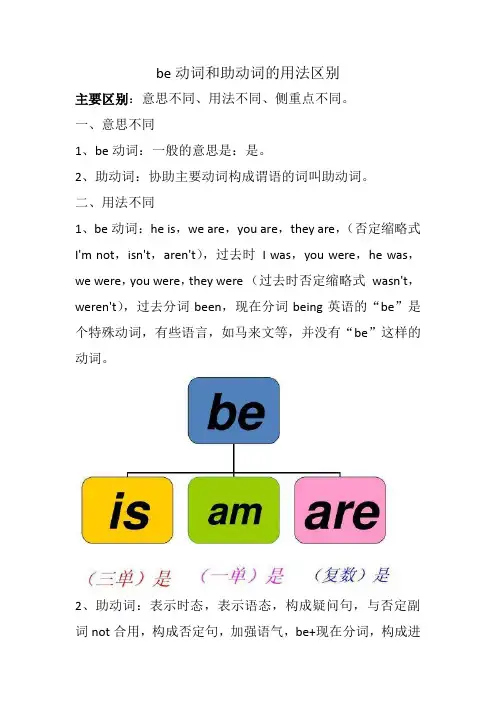
be动词和助动词的用法区别主要区别:意思不同、用法不同、侧重点不同。
一、意思不同1、be动词:一般的意思是:是。
2、助动词:协助主要动词构成谓语的词叫助动词。
二、用法不同1、be动词:he is,we are,you are,they are,(否定缩略式I'm not,isn't,aren't),过去时I was,you were,he was,we were,you were,they were (过去时否定缩略式wasn't,weren't),过去分词been,现在分词being英语的“be”是个特殊动词,有些语言,如马来文等,并没有“be”这样的动词。
2、助动词:表示时态,表示语态,构成疑问句,与否定副词not合用,构成否定句,加强语气,be+现在分词,构成进行时态。
be+过去分词,构成被动语态。
表示最近、未来的计划或安排。
表示命令。
表示征求意见。
三、侧重点不同1、be动词:be动词有七种形式:be, am, is, are, was, were, been, being。
2、助动词:助动词除be可作助动词,do,does,did,will,sha1l,have,hαs,hαd也作助动词。
四、复杂程度不同1、除了原形的be 之外,对于不同人称代词以及单数名词和复数名词,be 会有各种变化形式和缩写形式。
概括一下有七种形式:be, am, is, are, was, were, been, being。
它们与人称代词和名词单、复数的搭配关系是:现在时I am, you are, he/she/it/ is, we/you/they are;名词单数、不可数名词用is,复数用are。
缩略式I'm, you're, he's, we're, you're, they're否定缩略式I'm not, isn't, aren't过去时I was, you were, he/she/it/ was, we/you/they were;名词单数、不可数名词用was,复数用were。
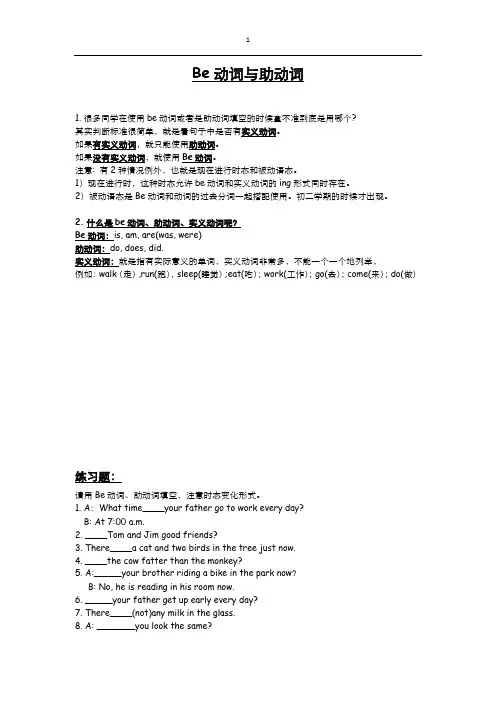
Be动词与助动词1.很多同学在使用be动词或者是助动词填空的时候拿不准到底是用哪个?其实判断标准很简单,就是看句子中是否有实义动词。
如果有实义动词,就只能使用助动词。
如果没有实义动词,就使用Be动词。
注意: 有2种情况例外,也就是现在进行时态和被动语态。
1)现在进行时,这种时态允许be动词和实义动词的ing形式同时存在。
2)被动语态是Be动词和动词的过去分词一起搭配使用。
初二学期的时候才出现。
2.什么是be动词、助动词、实义动词呢?Be动词:is, am, are(was, were)助动词:do, does, did.实义动词:就是指有实际意义的单词,实义动词非常多,不能一个一个地列举,例如:walk(走),run(跑),sleep(睡觉);eat(吃);work(工作);go(去);come(来);do(做)练习题:请用Be动词、助动词填空,注意时态变化形式。
1. A:What time____your father go to work every day?B: At 7:00 a.m.2. ____Tom and Jim good friends?3. There____a cat and two birds in the tree just now.4. ____the cow fatter than the monkey?5. A:_____your brother riding a bike in the park now?B: No, he is reading in his room now.6. _____your father get up early every day?7. There____(not)any milk in the glass.8. A: _______you look the same?B: Yes, we_______.9. A: _______Helen play the piano last night?B: No, she______.10. The American boy would like_______Zhang peng’s pen pal.11. A: Where _______you last week?B: I had a camping trip. I_______at a camp.12. _____everyone here today?13. ________tigers bigger than dogs?14. A: Where_______you an hour ago?B: I______at home.15. There______a lot of orange juice and some eggs on the table.16. I_____ten. My brother___ten, too. We____twin brothers.17. He______(not)like making model planes.18. We____(not)go to school on weekends.19. ______you speak English? Yes, I do.20. He____(not)do his homework last night.21. She_____cleaning her room now.22. She______(not)clean her room every day.23. She______(not)clean her room yesterday.24. Listen! Someone _____(singing)songs in the next room.25. Look! Someone ______(flying) a kite in the square(广场).。
be动词与助动词的用法第一篇:be动词与助动词的用法be动词与助动词的用法1.陈述句:be动词第一人称用am,第二人称用are,第三人称单数用is复数用are. 助动词do一般省略,直接用动词,注意动词时态和人称变化.有时在动词前加do,表示强调,加强语气.如:Do be quiet!2.疑问句:be动词直接提前,其他部分不变(由陈述句转变).助动词do同样,由省略直接提前放置,后面动词不变,注意do 的时态和人称变化.3.否定句:be动词和助动词do后面加not. be作助动词用的形式如下:①am, is, are, was, were ②助动词+be:shall be, will be, can be, etc. ③have/has/had + been(完成时)④am, is, …being(进行时)(1)表达进行时态句型 be + V-ing…(进行时态)例:What are you reading? (你正在阅读什么?) I am reading a magazine. (我正在阅读杂志。
)例:He will be taking a walk in the park at this timetomorrow morning. (明天早晨此时他将会正在公园散步。
)例:She has been teaching English in our school for years. (她已在我们学校教英语许多年了。
)解说第一例句是表达现在进行时,第二例句是将来进行时,第三例句是现在完成进行时。
(2)表达被动语态句型be +p.p. …(被动语态)例:English is spoken in both Canada and the United States. (加拿大和美国都讲英语。
)例:Those keys were found in your drawer. (那些钥匙是在你的抽屉里找到的。
be动词的变化规则当be在句子中作助动词的时候,当与动词的现在分词连用时,构成进行时态;当与动词的过去分词连用时,构成被动时态;当与动词的.不定式连用时,表示打算、计划做某事。
当be在句子中作系动词的时候,含义是“做、有”。
be动词用法:一、系动词bebe为连系动词,中心词义是"是",句型为"主+系+表"结构。
be的形式常用am, is, are(现在式);was, were(过去式);will/can/may/must be(助动词/情态动词+原形);have/has/had been(助动词+过去分词)等。
例句:To help animals is helping people.二、助动词be助动词be,无词义,辅助主要动词一起在句中作谓语动词。
用法如下:1、be+doing:构成进行时态,有现在和过去两种进行时态。
例句:The girls is reading and copying the new words now.2、be+done:构成被动语态(主语是动作的承受者,done必须是及物动词)。
例句:Tea is grown in my hometown.3、be+going to do,表示"打算或将要做某事",be有现在和过去两种形式。
例句:We are going to plant trees in the park.4、be+to do,表示"按计划安排将要做某事"。
例句:The new shop is not to be opened till next Monday.三、there be句型there be句式为:there be+主语部分+状语部分,表示"某处存在某物",be常用现在时,过去时和将来时等。
例句:There are about 80 pyramids in Egypt.四、实义动词be可以将be视为实义动词,因为它具有实际的词义,如"成为;做;发生;举行;逗留;到达"等。
Be动词和助动词用法区别其实be动词也是助动词(auxiliary verbs)。
英语动词大致可分为三种:助动词(auxiliary verbs),情态动词(modal verbs),实意动词(full verbs)。
助动词(auxiliary verbs):do,be,have。
没有实意,“帮助”别的动词,表示时态,否定和提问。
情态动词(modal verbs):can,must,may。
也是“帮助”别的动词,但是有自己的实意。
实意动词(full verbs):play,run,think。
其他有实意的动词。
be动词可用作助动词(auxiliary verbs):1,be+Ving:所有的进行时态,如:2,be+过去分词:被动式。
be动词也可用做实意动词(full verbs):be [bi]v.有;在;是。
你这样想,一个句子里要有动词吧。
再看看它们的名字,“be动词”和“助动词”,先说“be动词”,(1)这名字里有动词,说明他是动词,句子里有他就不会有别的动词(除非这些动词以别的形式出现,这是后话)了,(2)“am,is,are,was,were”叫be动词,是因为他们是be的不同形式再说“助动词”,(1)一定要注意“助”,是帮助的意思,说明他不是动词,只是起到了辅助的作用,所以,他们就一定要与动词同时出现。
[记住啊,他们离不开动词,但是动词没有他们也是可以的](2)did,do,does只是do的不同形式,根据你所需要的时态来选择(1)用于肯定句,否定句和疑问句am:第一人称单数(即只与 I 连用),用于现在时(一般现在,现在进行,只要那时态中是现在的就行) eg:①I am a girl.一般现在时②I am eating an apple.现在进行时③I am going to do my homework.[be going to 表将来,将来中只有这一种]is:第三人称单数,用于现在时(一般现在,现在进行,只要那时态中是现在的就行)(it就不举例了) eg:①She/He is a girl/boy.一般现在时②He/She is eating an apple.现在进行时③He/She is going to do his homework.[be going to 表将来,将来中只有这一种]are:第二人称单数,所有人称复数,用于现在时(一般现在,现在进行,只要那时态中是现在的就行) eg:①You are a girl.We/You(你们)/They are girls.一般现在时②You are eating an apple.We/You(你们)/They are eating apples.现在进行时③We/You(你们)/They are going to do our/your/their homework.[be going to 表将来,将来中只有这一种]was:第一人称单数,第三人称单数,用于过去时(一般过去,过去进行,只要那时态中是过去的就行)(it就不举例了) eg:①She/He was a girl/boy.一般过去·时回答be是一个连系动词,它有自己不同的形式现在时:be 进行时:being 过去时:was/were 过去分词:been 它的后面必须跟形容词或名词作表语,与之构成系表结构,充当句子的谓语。
be动词与助动词的区别与用法一、be 动词be 动词是英语中最基本的动词之一,其形式包括 am、is、are、was、were、been、being。
(一)用法1、表示“是”的概念I am a student(我是一名学生。
)She is beautiful(她很漂亮。
)They are friends(他们是朋友。
)2、表示状态He is ill(他生病了。
)The flowers are red(这些花是红色的。
)3、用于进行时态I am reading a book(我正在读一本书。
)They are playing football(他们正在踢足球。
)(二)be 动词的变形1、一般现在时第一人称单数 I 用 am第三人称单数 he/she/it 用 is第二人称及复数 you/we/they 用 are2、一般过去时第一人称和第三人称单数用 was第二人称及复数用 were二、助动词助动词本身没有实际意义,主要用于协助主要动词构成各种时态、语态、语气等。
常见的助动词有do、does、did、have、has、had、will、would、shall、should 等。
(一)用法1、构成疑问句Do you like music?(你喜欢音乐吗?)Does he come from China?(他来自中国吗?)Did they go to the park yesterday?(他们昨天去公园了吗?)2、构成否定句I don't know the answer(我不知道答案。
)She doesn't like coffee(她不喜欢咖啡。
)They didn't finish the work on time(他们没有按时完成工作。
)3、构成各种时态I have finished my homework(我已经完成了作业。
)(现在完成时)He is doing his homework(他正在做作业。
be动词、一般动词和助动词一、be动词、一般动词的现在式(1)be动词的现在式—am/are/isa.是(表状态)We are happy.—我们很高兴b.在(表存在)She is in America.—她在美国含be动词(am/are/is)的肯定句变成否定句时,在be动词后加not即可。
肯定句:主语+am/are/is…否定句:主语+am/are/is+not…He is a good baseball player.他是一个好棒球员(否定句)He is not a good baseball player.= He’s not a good baseball player.= He isn’t a good baseball player.含be动词(am/are/is)的肯定句变成疑问句时,将be动词拿到主语前,句尾加?即可。
肯定句:主语+am/are/is…疑问句:Am/Are/Is+主语…?1.That is his camera.那是他的相机(疑问句)Is that his camera?2.The girl is a junior high school student.那女孩是初中生(疑问句)Is the girl a junior high school student?动词开头的疑问句为一般疑问句,可用yes或no回答,而答句中的主语(问句)Am/Are/Is+主语…?(答句)Yes,主语+am/are/isNo,主语+am/are/is not1.Is that man your math teacher?Yes, he is./No,he is not.2.Are you eating your lunch?Yes, I am./No, I’m not.(2)一般动词的现在式凡是日常生活中具体的动作,如:eat-吃饭,walk-走路及抽象的动作如:like-喜欢,think-思考…皆为一般动词a.大部分动词加sworks/playsb.一般动词词尾为o/s/sh/ch时。
加esgo-goes/wash-washes/watch-watchesc.一般动词词尾为字音+y时,去y加iescry-cries/study-studieshave和hashas为have(有,吃)的单数形式They have a lot of money.He has a lot of money.含有一般动词从肯定句变为否定句时,不可直接在一般动词之后加not,必须使用助动词do/does/did。
且助动词之后用原形动词,因为助动词表示了时态、数的变化。
do—用于主语为I/you/复数does—用于主语为第三人称单数she/hedid—用于过去式,不分人称和数均可用肯定句:主语+一般动词…否定句:主语+do/does/did+not+原形动词1.The twin brothers go to school by bus.这对双胞胎兄弟坐公交车上学(否定句)The twin brothers do not(=don’t)go to school by bus.2.Sam has dinner at the restaurant.(否定句)Sam does not(=doesn’t)have dinner at the restaurant.否定句a.be动词He is my boyfriend.He is not my boyfriend.b.一般动词He likes dogs.He does not like dogs.含有一般动词的肯定句变成疑问句时,不可将一般动词拿到主语前,必须用助动词do/does/did,且助动词之后用原形动词。
肯定句:主语+一般动词…疑问句:Do/Does/Did+主语+原形动词…?1.You visit your grandmother on Sundays.(疑问句)Do you visit your grandmother on Sundays?2.He comes from England.(疑问句)Does he come from England?do/does/did开头的疑问句(即一般疑问句),其回答(问句)Do/Does/Did+主语+原形动词…?(答句)Yes,主语+do/does/didNo,主语+don’t/doesn’t/didn’tDoes the little boy go to school?Yes,he does./No,he doesn’t.比较疑问句a.be动词She is beautiful.Is she beautiful? Yes, she is.b.一般动词She loves tennis.Does she love tennis? Yes,she does.二、be动词、一般动词的过去式Be动词的过去式表示:过去时间中发生的状态1.(现在式)He is busy now.(他现在很忙)(过去式)He was busy then.(他那时很忙)2.(现在式)My parents are at home now.(过去式)My parents were at home yesterday.时间副词改变,动词也应改变。
was和were现在式过去式be动词amisarewaswerebe动词过去式的否定句含be动词过去式was/were的肯定句边否定句时,在be动词后加not.肯定句:主语+was/were否定句:主语+was/were+not…1.Mr.Brown was a vet.Brown先生是一个兽医(否定句)Mr.Brown was not(=wasn’t)a vet.2.Joe and Brain were in the living room at that time.(否定句)Joe and Brain were not (weren’t )in the living room at that time.含be 动词过去式was/were 的肯定句变疑问句时,将was/were 拿到主语前,句尾加?即可。
肯定句:主语+was/were … 疑问句:was/were+主语…?1.Wendy was in the seventh grade last year. Wendy 去年读七年级(疑问句)Was wendy in the seventh grade last year?动词开头的疑问句,可用yes 或no 回答,而答句中的主语用代名词。
(问句)Was/Were+主语…?(答句)Yes,主语+was/were/No,主语+was/were+not.Were you a pianist? 你是钢琴家吗?Yes, I was./No, I wasn’t.1.I walk to school every day .(过去式)I walked to school yesterday .2.Mother goes to a supermarket every morning .(过去式)Mother went to a supermarket yesterday .—主语为第三人称单数时,动词过去式不加s 。
含一般动词过去式的肯定句变否定句时,不可直接在一般动词之后加not ,必须用助动词did (不分人称和数),而助动词之后用动词原形。
肯定句:主语+一般动词…否定句:主语+did not+原形动词1.He called you last night.他昨晚打你电话(否定句)He did not call you last night.2.My sister and I watched TV all day yesterday.(否定句)My sister and I didn’t watch TV all day yesterday.否定句过去式a.be动词She was at home.She wasn’t at home.b.一般动词She studied English.She didn’t study English.含有一般动词过去式的肯定句变为疑问句时,不可将一般动词拿到主语前,必须用过去式助动词did,且did之后必须用原形动词。
肯定句:主语+一般动词过去式…疑问句:Did+主语+原形动词…?1.His friends went to that movie case week.(疑问句)Did his friends go to that movie last week.(答句)Yes,they did./No,they didn’t.2.Grace wrote a letter to David.(疑问句)Did Grace write a letter to David?(答句)Yes, She did./No,she didn’t.疑问句过去式a.be动词He was sick.Was he sick.b.一般动词He did his homework.Did he do his homework?三、助动词所谓助动词是和原形动词合在一起,用来表现时态、语态、语气的动词。
此外,助动词也能表示疑问、否定、强调…1.其后须接原形动词He can speak English.✓He can speaks English.✗2.现在式中,主语为第三人称单数,词尾不加sHe cans speak English.✗3.形成否定句时,在助动词后加notHe cannot speak English. ✓He doesn’t can speak English. ✗4.形成疑问句时,将助动词拿到主语前Can he speak English? ✓Does he can speak English? ✗5.两个助动词不能连用You will can swim soon. ✗(1)can(could)Can表能力、许可、可能,而could是can的过去式a.表能力(=be able to)1.He can speak Japanese, but he cannot(=can’t)write it.2.I will be able to(此处不能用can)finish the paper and go out to see the exhibition tomorrow.3.I haven’t been able to recall his name.我一直想不起他的名字b.表可能1.It cannot be true.那不可能是真的2.This kind of thing can happen every now and then.这种事随时可能会发生3.A quarrel can sometimes cause trouble.口角有时可能引发问题4.The light in the sky could be a UFO.天空中的光可能是外星飞船c.表许可1.You can come in if you have a ticket.如果你有门票就可以进来2.I’m afraid you can’t park your car here.恐怕你不能把车停在这儿3.Can I leave early because I’m not well today?——Certainly.因为我今天不舒服,可以早点离开吗?——可以d.表请求1.Can you do me a favor?你能帮我忙吗?✧Could you do me a favor?是更可气的说法Could you repeat your cell phone number,please?请你重复一遍你的手机号码好吗?(2)may(might)a.表许可1.You may not chew gum in class.你不可以在课堂上嚼口香糖2.May I interrupt you?——sure.我可以打断你吗?——当然b.表可以1.You may be right but I am against your opinion.你可能是对的,但是我反对你的意见2.She might not know that you are here.她可能不知道你在这儿➢Might可用于现在式或过去式,其表示的可能性较may低c.表意愿、祈祷1.May I never see a sight like that again!愿我不再看到那样的景象2.May you succeed.愿你成功(3)musta.表义务、命令1.You must return this book by next Tuesday.你必须还书在下周二之前2.You must not talk with your mouth full.你不可以在嘴巴有东西时说话➢Must I really attend the meeting?我真的必须参加那场会议吗?——Yes,you must.——No, you need not.——No, you don’t have to.Must=have to(必须),但must只能用于现在式,其过去式用had to,未来式用will have to,完成时用have had to1. I had to go to see the doctor because I caught a cold.我必须去看医生,因为我感冒了2.You’ll have to replace this light bulb.你将必须更换这灯泡3.We have had to stay here because it’s raining heavily outside.我们必须一直呆在这里,因为外面在下大雨➢口语中,常用have got to 代替have to1.You’ve got to be more patient,Mary.Mary你必须更有耐心b.表推测1.You must be kidding.你一定是在开玩笑2.That is an enormous animal, it must weight a ton.那是个巨大的动物,它可能有一吨➢表推测是的must,其否定用cannot代替1.She is very young. She cannot be over twenty.她非常年轻,她不会超过二十岁c.表必然1. All men must die.人一定会死(4)willWill除表未来外,还有下列用法a.表现在的推测1.Mom will be downstairs now.妈妈现在应该在楼下吧2. That will be his house.那应该是他家吧b.表主语强烈的意志1.The window will not open.窗户怎么也打不开2.He will insist on his right.他将坚持他的权利c.表习惯、倾向1.Accidents will happen.事故将发生2.A drowning man will catch at a straw.溺水者将抓住一根草d.表请求1.Will you bring me a ladder?麻烦给我拿个梯子好吗?2.Will you have one more coffee?你要不要再来杯咖啡?(5)wouldWould为will的过去式,但would有其独特的用法a.表客气的请求1.Would you mind if I sit next to you?你介意我坐你旁边吗?2.Would you call me back later?请稍后打给我好吗?b.表过去的习惯,常伴随着sometimes/often…频率副词1.Before they had television, people would listen to the radio.在有电视之前,人们习惯听收音机2.Susan would often chat with us at this coffee shop.Susan以前经常和我们在这家咖啡厅聊天C.表过去的意志1.You wouldn’t eat carrots when you were a boy.你小时候不愿吃红葡萄2.The rusty screw wouldn’t come loose.生锈的螺丝拧不开(6)used toa.表过去的习惯1.John used to work part-time at a restaurant after school. John以前在下课后常到餐厅打工2.I used to go for a swim on my lunch break, but now I don’t.我以前常在午休时间去游泳,但现在不去了3.I used to go to the movies every Sunday.我以前每个星期天常去看电影I would often go to the movies when I was young.我年轻时常去看电影✧Used to 表过去的习惯Would 表过去动作的重复,其习惯意味较淡Used to的否定为used not to或didn’t used to。